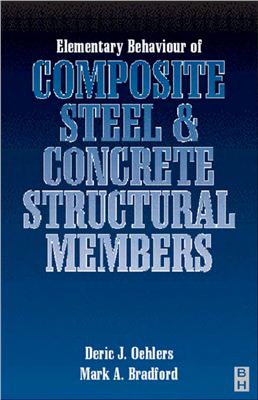Buttеrworth-Hеinemann, Elsevier, 2002, 259 pages
This book is aimed at developing elementary analysis skills, familiarity and an intuitive feel for composite construction that is required by undergraduate and graduate students, and by structural engineers. It does not require a prior knowledge of advanced analysis and design techniques, and builds on simple concepts such as statics and the mechanics of materials. A topic is first introduced by a brief description, with numerous carefully-chosen examples forming an integral part of the main text. Working through the examples allows the reader to gain a full understanding of the subject, as a technique is illustrated by its application to designing new structures, or in the important area of assessing and upgrading existing structures.
The techniques described for the analysis of standard structures form a basis for understanding the way composite structures work, and these techniques are applied to many non-standard forms of composite construction that are not, or rarely, covered in national standards. The book is an essential purchase for all undergraduate and postgraduate students of structural/civil engineering and architecture, as well as all practising structural and civil engineers.
Covers practical applications not covered in codes, such as service ducts, splitting, upgrading existing structures and non-standard forms of composite construction
Topics are embellished by working through numerous unique and carefully-chosen examples that form an integral part of the subject material
Not orientated to specific codes, so that principles can be applied to any national design standard
This book is aimed at developing elementary analysis skills, familiarity and an intuitive feel for composite construction that is required by undergraduate and graduate students, and by structural engineers. It does not require a prior knowledge of advanced analysis and design techniques, and builds on simple concepts such as statics and the mechanics of materials. A topic is first introduced by a brief description, with numerous carefully-chosen examples forming an integral part of the main text. Working through the examples allows the reader to gain a full understanding of the subject, as a technique is illustrated by its application to designing new structures, or in the important area of assessing and upgrading existing structures.
The techniques described for the analysis of standard structures form a basis for understanding the way composite structures work, and these techniques are applied to many non-standard forms of composite construction that are not, or rarely, covered in national standards. The book is an essential purchase for all undergraduate and postgraduate students of structural/civil engineering and architecture, as well as all practising structural and civil engineers.
Covers practical applications not covered in codes, such as service ducts, splitting, upgrading existing structures and non-standard forms of composite construction
Topics are embellished by working through numerous unique and carefully-chosen examples that form an integral part of the subject material
Not orientated to specific codes, so that principles can be applied to any national design standard

